Price and pricing are important to our business. It directly impacts revenue. It can help convey the value of our products.
As a key component of the marketing mix, we can spend an extensive amount of time discussing price.
So, we are going to do just that. Here, is an overview.
What is pricing?
Price is what customers pay for a product or service. It is a measure of the value placed on a product, both by the buyer and the seller.
It’s a key component in the marketing mix. Being one the most direct ways of communicating value to a customer. Also, price is the one component of the marketing mix that has a direct impact on a product or company’s revenue and profitability.
Thus, pricing is the act of determining the price of a given product or service. Using the marketing mix and various pricing strategies and tactics to accurately convey the value of a product or service.
Price in the Marketing Mix
The marketing mix, whether looking at the 4Ps, 7Ps, or 4Cs model, include price. It is arguably the most important component. And being the most important component, it can be the most difficult to master.
Within the context of the marketing mix, price is the only revenue generating component. Also, pricing needs to support the other areas of the marketing mix.
What does that mean?
Pricing has to be the vehicle in which all other functions can be performed. Providing enough resources to invest in developing a superior product. Enough revenue to invest in promotion, as well as gaining the correct placement.
As this factor that impacts revenue and profit, which then fuels the rest of the business, it is the foundation to your business model.
Think of price as the foundation to the marketing mix.
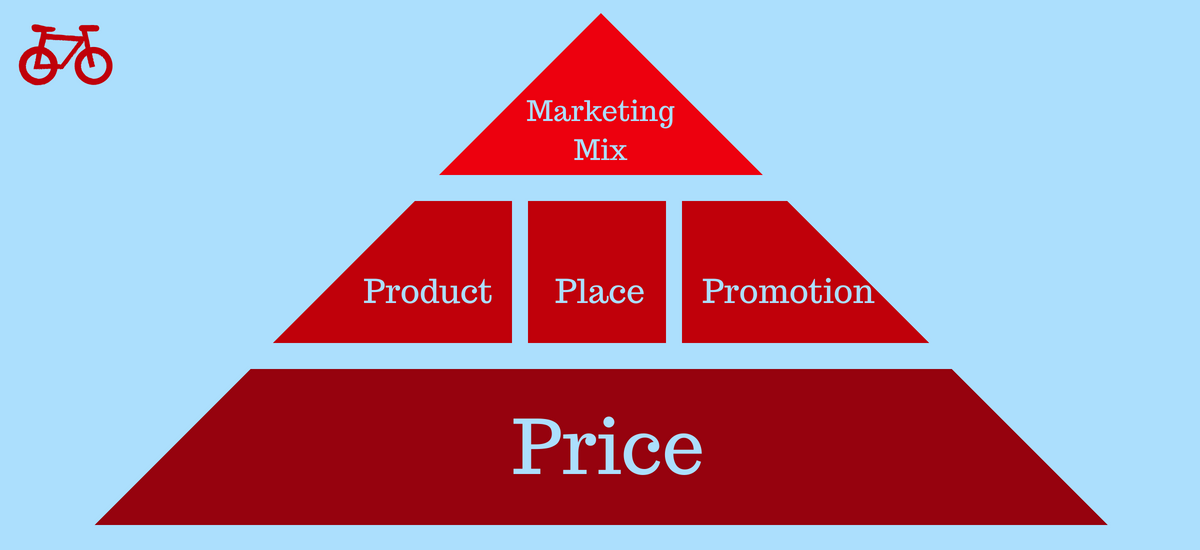
View Points on Price
There are two possible views to pricing. The buyers view and the sellers view.
Each party views pricing differently, but it is one of the most direct forms of communication between buyers and sellers.
The buyers view is the monetary value of a product.
But, it will also contain time and additional resources needed to use a product. Thus, the buyers view is everything included in using a product.
Time, resources, and money.
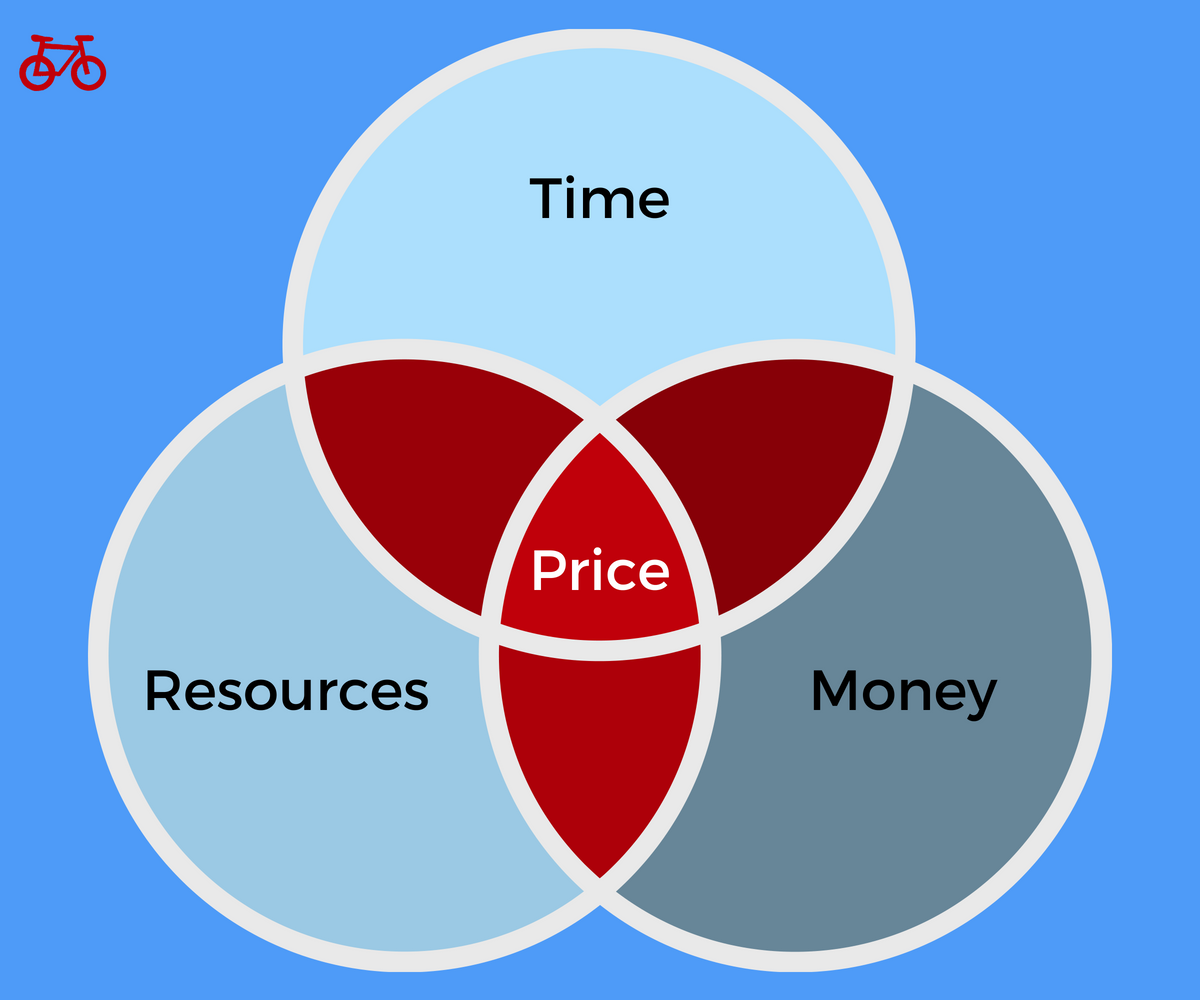
Alternatively, the sellers view is the direct communication of value to the customer.
Although this is not the only way a seller communicates value to a customer, it is one of the most direct and widely accepted forms of value communication.
A seller also views price as a competitive strategy, positioning, and branding technique.
Both buyers and sellers view this as an important communication and exchange medium in the buying and selling process. It then makes sense to thoroughly understand each of their perspectives regarding price.
The Role of Pricing
The impact of pricing is more than just what a customer will pay to use your product or service. The role of pricing crosses over all aspects of the marketing mix and your marketing plan.
Some of the roles that pricing plays in the marketing mix are:
Branding
Pricing can impact your branding and positioning efforts. Either positively or negatively.
For example, if you price your product too low, you can be seen as cheap. If this is the strategy, then that is great. If not, then you are negatively impacting the brand.
Alternatively, pricing too high can give your brand the perception that you are overpriced. Or, it can be your signal that you are a luxury brand.
In any of these situations, you want your price to be in line with your branding efforts.
Product Adoption
Pricing can play a major role in gaining product adoption. This can be done through discounts, promotions, or even rebates.
If you are needing to cause someone to change, the price can help do that. Either by saving money, getting more value, or many other reasons. Either way, price can be a significant driver for product adoption.
Sales Volume
Price can help increase sales volume. In the context of sales volume, this would be running promotions, discounts, or product bundling to increase purchase volume.
For a short-term increase in volume, manipulating price can be one of the most effective methods.
Market Share
Aggressive pricing is one common way price can contribute to increasing market share. This is a predatory practice, which can help drive product adoption from competitive product users.
Manipulating price can be an effective piece of a market share growth strategy.
The role of pricing is not limited to the points above. It has a wide-reaching effect in the marketing mix and plays many roles. Adjust your price, and you affect many areas of your business.
The Components of Price
There are three major components in price. Cost, price, and value.
Each have a specific function and purpose, which are:
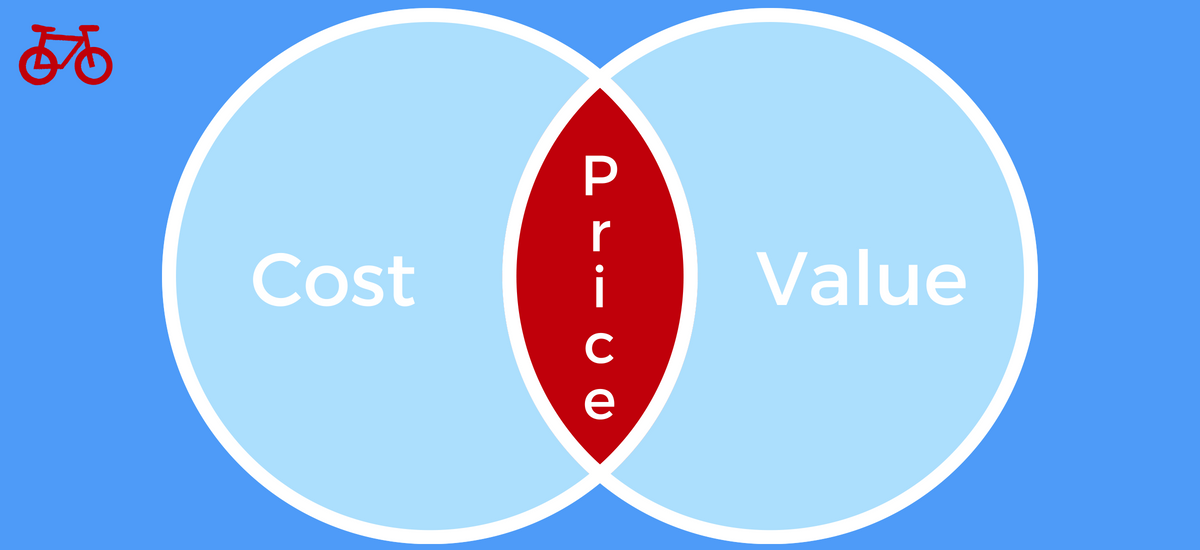
Cost
The total cost to produce, market, and acquire customers for your product.
Price
The monetary value used to exchange goods and services between buyers and sellers.
Value
The perception of your product to your customers.
These three components give us the price vs. value relationship. Which is the connect, or disconnect, between the price the customer pays and the value they perceive. In a perfect relationship, price is equal to the value.
Aside from these three primary components of pricing, there are three major theoretical considerations we should look at.
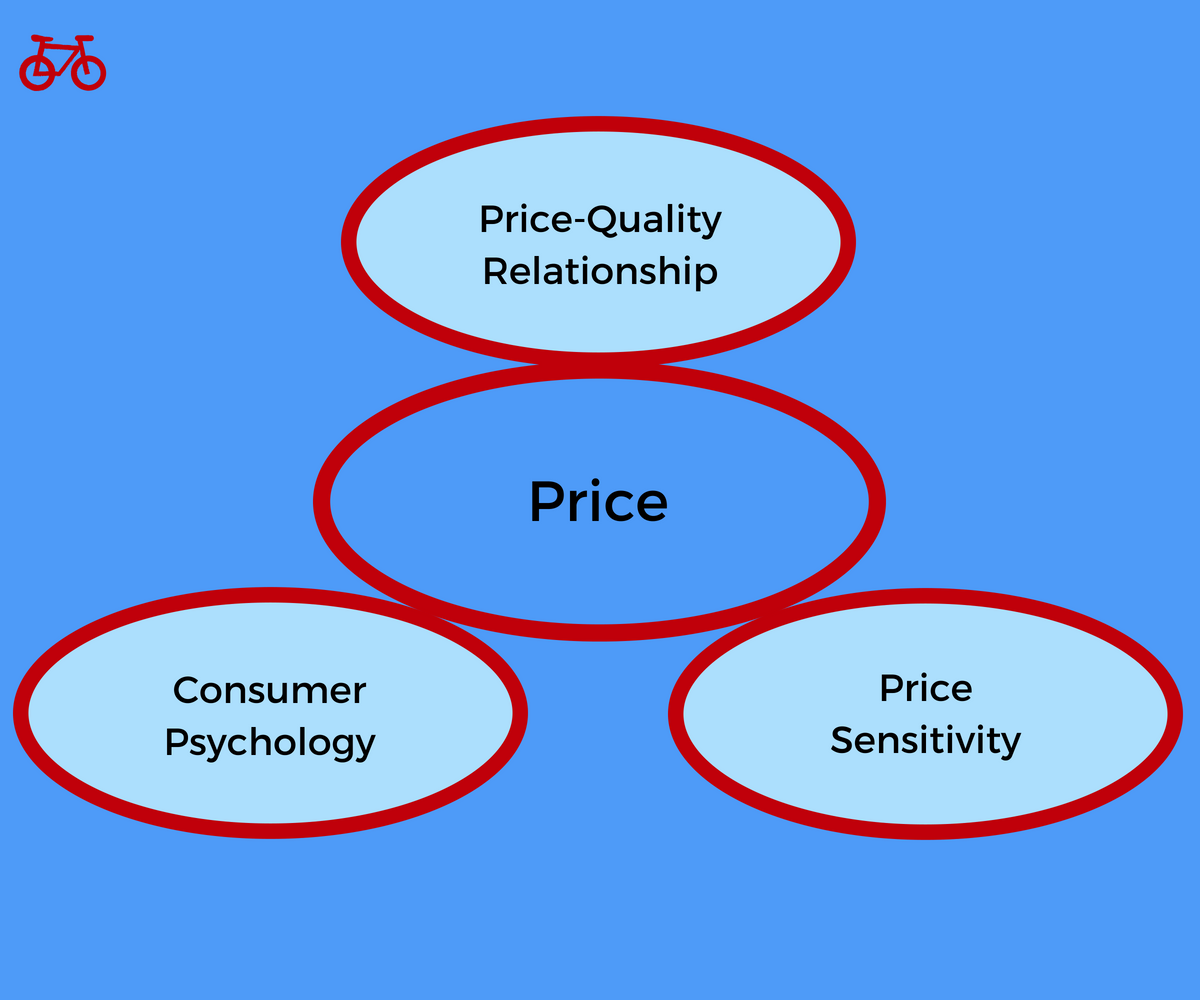
Price-Quality Relationship
Price-quality relationship is the way a customer uses price to determine the quality of a product. This can be accurate, or inaccurate, depending on the circumstance. At times, there can even be little correlation between price and quality.
That being said, this is an important reality we have to consider when pricing our products.
Price Sensitivity
Price sensitivity is the concept of how sensitive your customers are to price. This can either be existing customers sensitivity to a price increase, or prospective customers sensitivity to how you are priced in the market.
Having at least an idea of price sensitivity within your target market can allow you to be aggressive with price if you need to be. Or, you might be able to command a less competitive price if the value of your product allows it.
Ultimately, it can help prevent pricing too high, as well as pricing too low.
Consumer Psychology
Consumer psychology, as it relates to price, is the act of using perception to help justify a price.
What that means is, using the psychology of the customer to help them validate that your price is fair, or a good deal, and act on buying. For example, using marketing messages to explain the value of your product, or using discounts to alter the perception of value.
You can even go as far as using 9’s in the price, such as your product costs $9.99, which studies have shown that the 1 cent difference can increase sales.
The psychology aspect is using human behavior to create successful pricing strategies.
As we continue through our pricing overview, we will take a look at some of the factors that determine price next.
What are price determining factors?
When looking at what factors determine price, we could spend entire courses on the factors.
Here, we are going to take a glance at a few of the most prominent pricing factors.
The following are some of the most common price determining factors from the seller’s perspective.
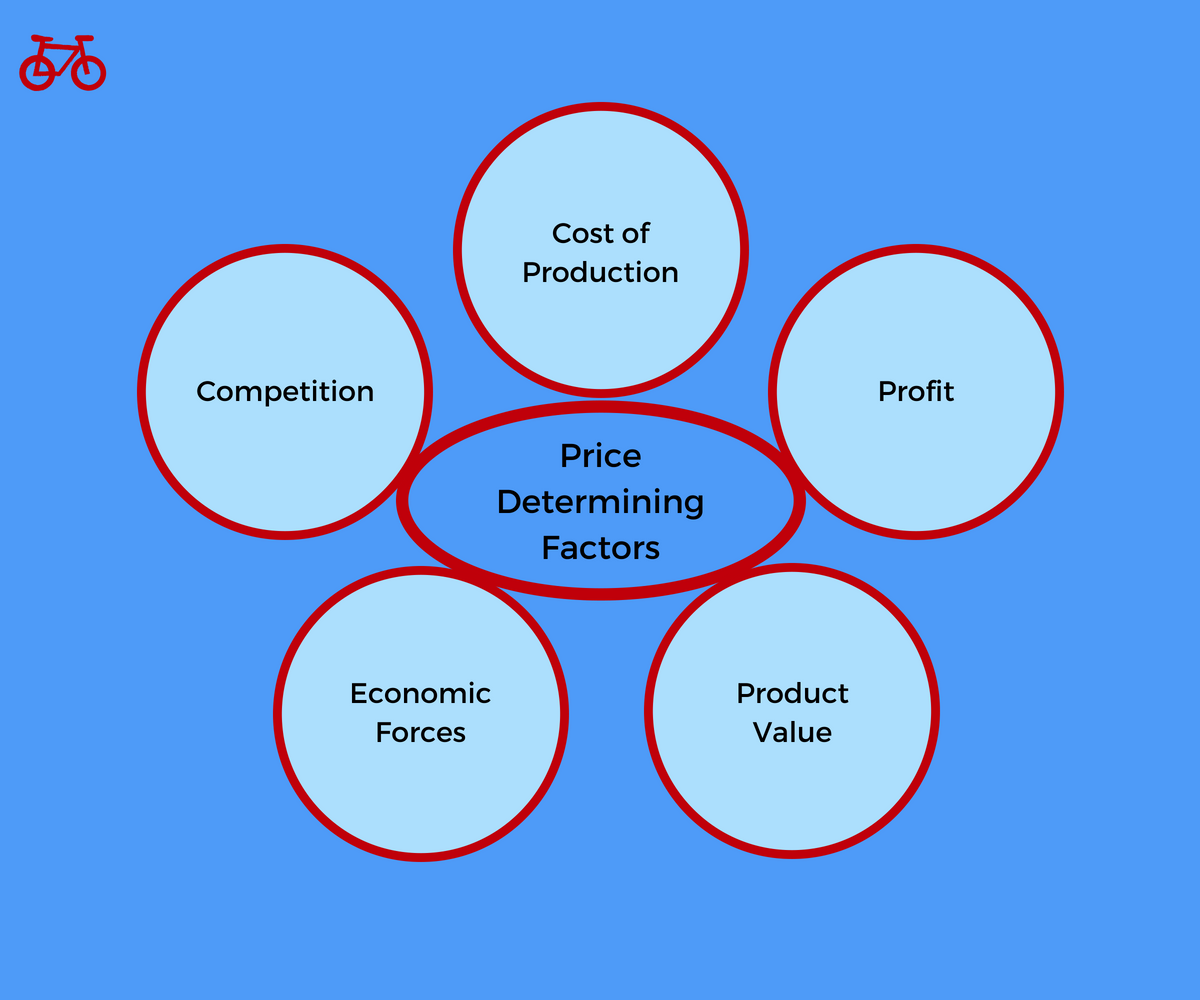
Cost of Production
The cost of production, or the total costs of your product, tend to be one of the most common ways to price a product. This is obvious, because if you price a product below cost, you lose money on each sale.
But, this should not be the only factor we use in pricing out our products.
Competition
Monitoring our competitors price is important. Our price needs to be in the ballpark of how the market is pricing products.
This factor is all about basing our pricing decisions on what our competitors in the market are doing.
By using our competition as the benchmark of our products price, we can then decide whether we want to be cheaper, or we are willing to be more expensive, but different.
Profit
Using profit, or profit margin, is another factor to consider with pricing. This consists of determining how much the company wants, or needs, to make when selling each product.
Meaning, the price the customer is paying minus all the costs to produce and market the product. This will get you the profit on a per product basis.
Many companies need a specific profit margin to make operating a company profitable. Thus, pricing products by keeping the profit margin in mind can contribute to the overall pricing strategy.
Economic Forces
Economic forces can determine how a product is priced. At times this can mean that you are able to charge more for a product during a great economy and less for a product during a down economy.
Maybe unemployment is one of the economic factors to consider. Or, depending on your target market, it can be the ability of your customers to pay.
There are many economic factors, these are just some of the simple ones. But, they are factors that determine prices. Usually, they are factors you, the seller, have very little control over.
Product Value
Another factor that is commonly used in determining prices is the products value. This can either be the value you see your product delivering.
Or, this can be the value that your customers perceive.
Value as a price determining factor is difficult, because a lot of times you’re using buyer perception to create a price. Value is the perception of your customers.
These are just some of the most common factors in pricing products. There are plenty more factors. Both in how your product is priced, as well as what you can use in your pricing strategy.
What is Price Strategy?
Price strategy is the overall, high level, components of pricing your products. It is the practice of how the marketing mix factor of price is handled for a product and within an organization.
There are many decisions, factors, and tactics that going into addressing price. There are business objectives that need to be determined. Also, the of role of pricing within the marketing mix, the product, and the company will have to be addressed.
But, a pricing strategy takes all these factors into account and creates a price that fits within the marketing mix and the company.
Pricing Business Objectives
Companies can have different pricing strategies that are based on the overall business objectives. For example, it is not always necessary to be focused on profit as a business objective. Thus, a pricing strategy would reflect this.
Amazon has been notorious with a pricing objective that produces razor-thin margins. But, the objective was growth. That being said, we are going to take a look at a few pricing business objectives.
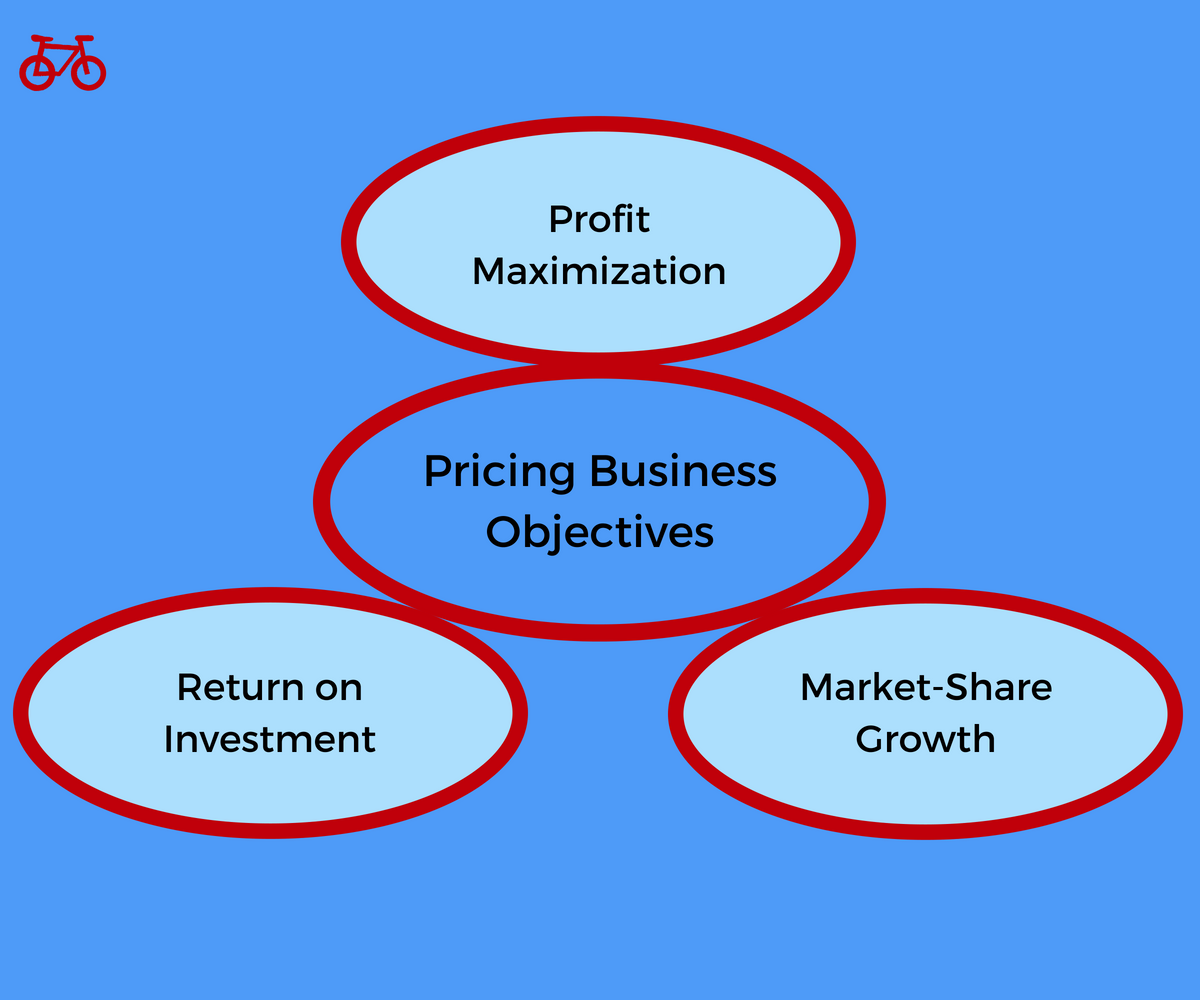
Profit Maximization
One strategy is to price products according to maximizing profit. This strategy is used for highly differentiated products. High innovation or patent protected products will tend to utilize this strategy.
Return on Investment
Return on investment (ROI) or return on assets (ROA) is an objective where pricing is based on recouping costs of a particular investment.
The strategy used in this objective is almost exclusively the cost-plus pricing strategy.
Typically, a company would look at a time frame where particular costs need to be recovered. Then, the pricing is designed to reflect that. This is often seen in real estate investments. But, it is not a strategy limited to this industry.
Market-Share Growth
Specific pricing strategies can be used to accelerate market-share growth. Mainly, lowering prices can be used to capture new segments of the market.
Amazon is a great example of this strategy, which they continually use low prices and razor thin margins to capture markets. Often, they have been publicly criticized over extended use of this strategy.
Capturing market share at near loss pricing can be leveraged at a later period with an increase in pricing.
These are just a few pricing business objectives that can be used.
Now, let’s consider different pricing strategies and tactics and how they can be used together to create and an effective price component of the marketing mix.
Pricing Strategy vs. Pricing Tactics
When determining your prices, there are two levers you can use. Strategy and pricing tactics. Both are a component to optimize price and both should be used.
Strategy is the overall pricing decisions you make. That means your overall long-term approach to pricing. On the other hand, there are pricing tactics. These are the short-term manipulations in your price to capture quick gains. Or, to cause customers to act now.
Below, there are some of the most common pricing strategies and pricing tactics.
Pricing Strategies
Pricing strategies are the long-term decisions you make about your price. The following are some of the most common pricing strategies.
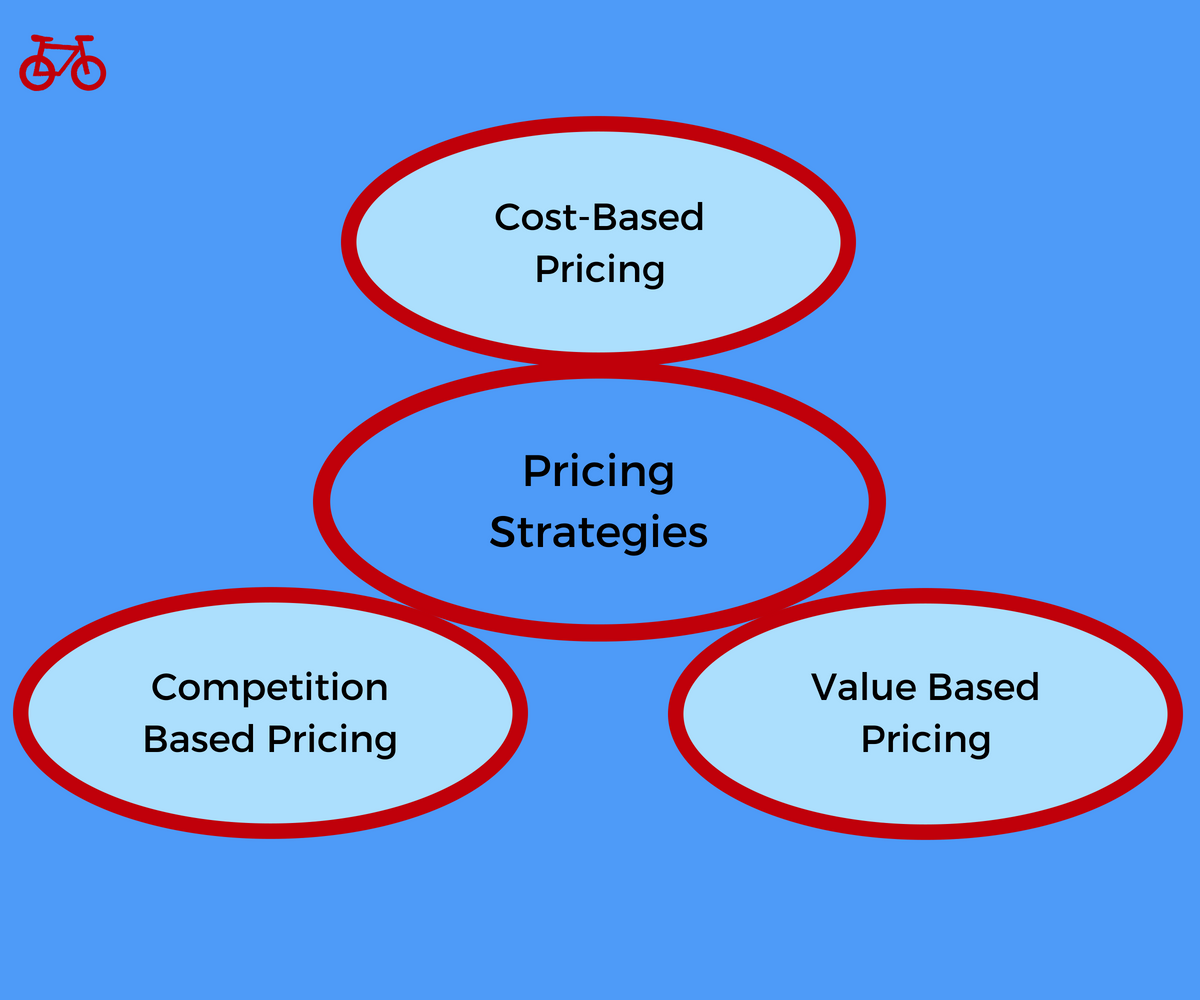
Cost-Based Pricing
The cost-based pricing strategy is pricing your goods or services as a fixed income markup. Or, it can be a percentage of the cost that is added to the cost.
Ultimately, the cost-based pricing strategy prices your product as a markup on the cost to produce or acquire your product.
Competition Based Pricing
Competition based pricing is taking a look at how your competitors are pricing products and then basing your price on their pricing.
Your pricing strategy here can either be looking at direct competitors. Or, you can look at all the players in your sector, being direct and indirect competitors, and base your pricing on this information. Then, you can either be matching their prices, beating their prices, or being more expensive to be the premium option.
It is essentially copying the pricing of your industry so you are within the average of what customers expect to pay for your type of product.
Value Based Pricing
Value based pricing, which is similar to demand based pricing, is pricing your product based on its perceived value.
Often, this is based on the value of a brand or creating the perception that the product is of high value. This tends to be the pricing tactic at the high end of the market. But, you can also use it for moderately priced products, where the price and quality are perceived as correlated.
Value based pricing is flexible. It can be desirable from a seller’s perspective, as the profit can be increased as the perception of value is increased.
These are just a few pricing strategies, which they are not mutually exclusive. You can use a combination of strategies based on your business objectives.
Pricing Tactics
The next way to optimize price is through various pricing tactics. As mentioned above, these are the short-term manipulations to get customers to act immediately.
The following are some common pricing tactics.
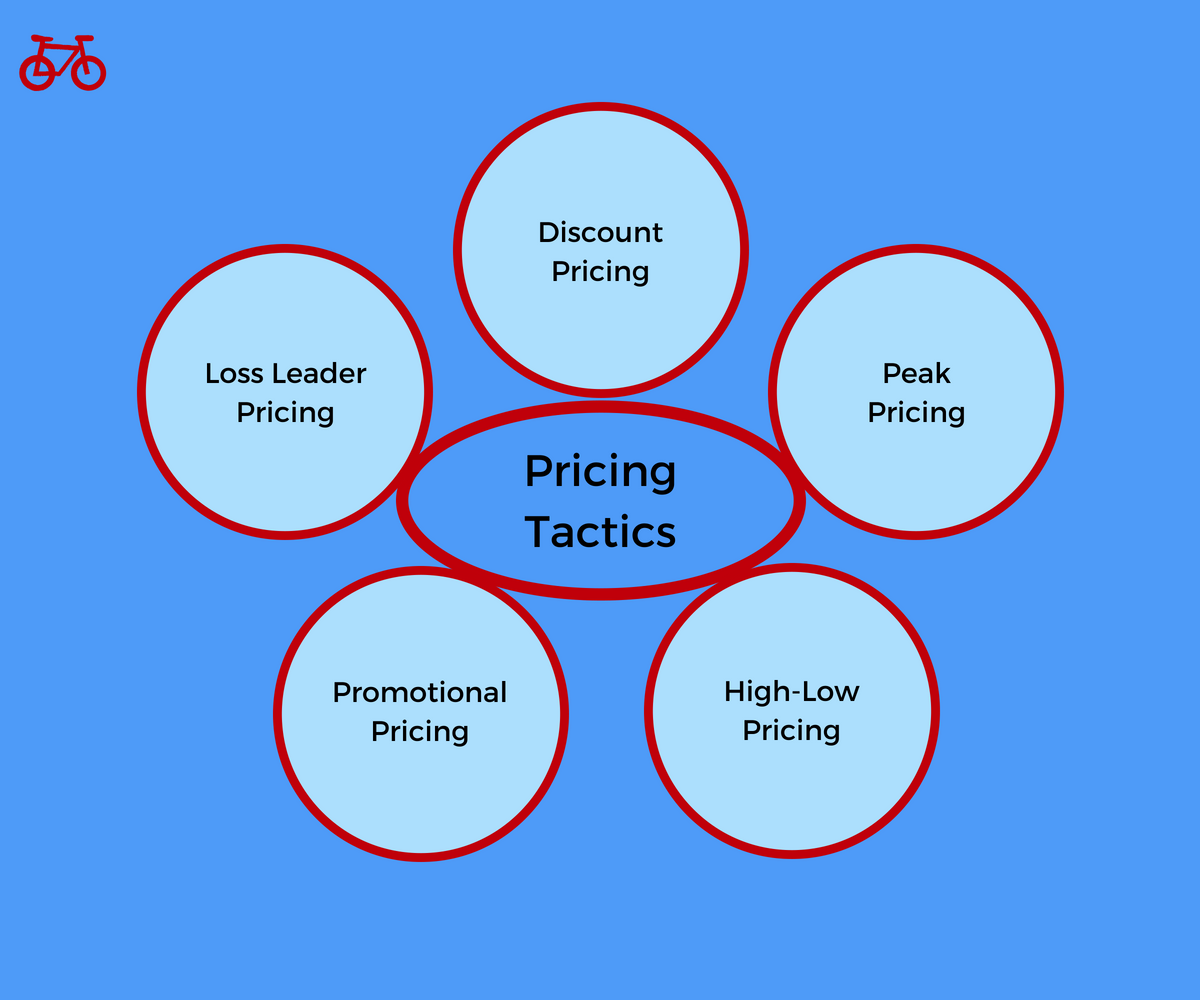
Discount Pricing
The discount pricing tactic is decreasing your products price temporarily in order to increase sales volume. This is a heavily used tactic and quite effective.
It can be used during seasonal promotions, clearing house promotions, or promotion’s during different product lifecycle stages.
Loss Leader Pricing
The loss leader pricing tactic is pricing a particular product in your portfolio artificially low in order to promote the purchase of additional products at higher prices.
Essentially, this is the gate way product. The initial purchase price is low, to get the product adoption. Then, there are additional purchases that are needed. This continues the purchase pattern, which can then makeup for the loss of the initial sale.
In one form, it looks like the razor, razor-blade model. Where the razor is sold at a loss, but the razor blades contain a nice profit margin.
Peak Pricing
Peak pricing is using demand timing in order to increase and decrease prices. This can also be considered dynamic pricing, which is keeping prices continually changing with rapidly changing demand.
This is most common in the travel industry and airline industry. Uber is making this tactic famous again with its common surge pricing.
This is a great tactic if demand is frequently changing. And, that change in demand is predictable.
Promotional Pricing
Promotional pricing is a form of price manipulation where the focal point is adjusting the perception of value for a short period. This can be lowering the products price. Or, offering more goods for the same price.
There are many other ways to enhance the perception of value. But, the goal in promotions is targeting value perception to justify the price manipulation.
High-Low Pricing
The high-low pricing tactic is where a company will set a high price for a product while the popularity is high. Then, when popularity decreases, the company will lower the price.
This is very common in the fashion industry, where the initial release of a line has high prices. Then, when the style is no longer new, there are deep sales discounts.
The pricing tactics above are just a few of the more common ones used. Just like in pricing strategies, these are not mutually exclusive. They can be used together and with different pricing strategies.
All of this is to get you to a point of the best price for your products.
How to set Prices
After looking at all the different strategies, tactics, and reviewing your business pricing objectives, you can now set your prices.
Once pricing is beginning to be set, it is a good practice to test various prices to get to the correct price. This can include A/B testing, customer segment testing, or target marketing testing.
Then, you can set your price and continually review to ensure your prices are always up to date.
Common Pricing Mistakes
Now that we have gone through setting pricing objectives, pricing strategies, and tactics, we can look at some common mistakes.
The following are some common pricing mistakes.
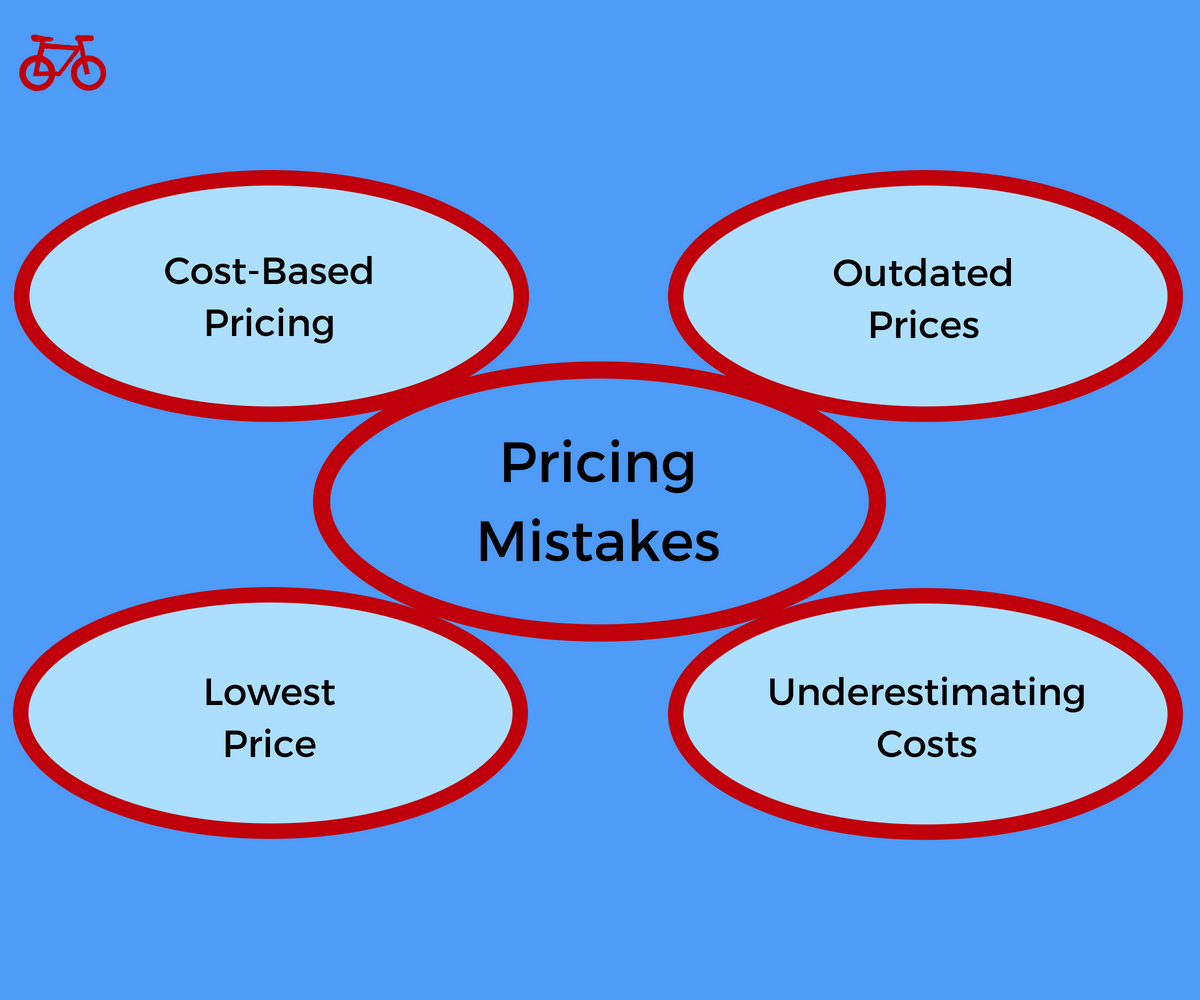
Cost-Based Pricing
Cost-based pricing is a common pricing strategy. But, it can cause a narrow pricing strategy.
Either pricing can be set too low because there is more value in the product than is reflected in the cost. Or, the price can be too high, because there was no competitive benchmark used.
It is best not to rely solely on the cost-based pricing method.
Outdated Prices
Not updating prices is a common mistake. Not updating prices can occur for various reasons. Like a fear of raising prices or just not thinking about it.
It is good to have a process to review prices every so often to ensure prices are always competitive, relevant, and up to date.
Lowest Price
Another common mistake is thinking you need to be the lowest price. It’s not just thinking you need to be the lowest price, but also being the lowest price.
This is the “race to the bottom” trap. With some products, the lowest price is the best strategy. But, with many products, there is plenty of value and differentiation to be gained.
Don’t assume you need to be the lowest price. Sometimes you can use some marketing prowess and raise your prices.
Underestimating Costs
Costs can be tricky. Incorporating all of them is tough. But, the price of your product might be too low if you do not understand all your costs.
Some costs to consider are production costs. But, these are obvious. There are also acquisition costs, advertising costs, marketing costs, and employee costs.
All should be considered in the pricing of a product.
What is Price Optimization?
Price optimization is the mathematical, and sometimes scientific, approach to determining the best price for your product. Optimizing price is an ongoing process.
It is the act of continually adjusting your products price to ensure that you come up with the best price. The best price that will maximize profit and sales volume. There will need to be continual testing, competitor monitoring, analysis, and trial and error.
There are many factors and metrics to look at when optimizing your price. You can look at sales volume, profit margin, market share, and many others. In order to optimize your price, you need to setup up a mathematical process for testing and iterating your price.
Price is the foundation of the marketing mix. It is the only component that directly impacts revenue and profit. All other aspects of the marketing mix should work in conjunction with price.
That being said, it is one of the most complex components to get right. By using the factors above, hopefully you can make better decisions regarding your pricing strategy.
